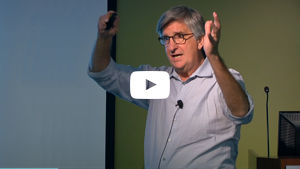Brain Awareness Night Highlights Importance of Childhood Resilience
- Tweet

On March 15, more than 100 people from around the Memphis community gathered for Brain Awareness Night, hosted annually by the Urban Child Institute and the University of Tennessee Health Science Center’s Neuroscience Institute. This year’s event, featuring speakers Dr. Pat Levitt and Dr. Eraina Schauss, focused on the topic of childhood resilience.
Resilience is defined by the American Psychological Association as the ability to adapt well to adversity, trauma, tragedy, threats or even significant sources of stress. Resilient children manage to thrive despite being exposed to risk factors like poverty or problematic home environments. Resilience is not a trait that an individual either has or does not have, but is rather a skill that can be developed.
Early Experiences Set the Foundation
As the brain develops, neurons form strong circuits for various functions, such as motor skills, emotions, and language; the more a skill is used, the stronger and more efficient that particular circuit becomes. Though genetics play a part in determining brain structure, it is clear that experiences, especially early on, have an equally significant role.
“Experiences are really important—they drive development of the brain,” said Dr. Levitt. “There's a blueprint that's set up prenatally to get the basic connections to form, then experience drives further development through infancy, toddlerhood, childhood, and well past adolescence.”
The Influence of Negative Experiences
Since experiences can have such profound influences on the brain’s architecture, it is important to consider just what kind of experiences a child is being exposed to. Studies have shown that these events can affect a child his entire life, both emotionally and physically.
When a child is exposed to stress or trauma, his body activates a stress response. If he receives comfort from an adult, his body will return to its normal state. However, if he is exposed to ongoing trauma, such as neglect or abuse, with no intervention from an adult, the stress response will remain activated. Studies have shown that this constant activation, known as “toxic stress,” can weaken and reduce neural connections in the brain related to learning and reasoning.
Early negative experiences have also been linked to long-term consequences related to physical health. One line of research, known as the ACE Study, looked at how adverse childhood experiences (ACEs) can have lifelong repercussions. ACEs can include emotional neglect, physical abuse, and/or living with a parent suffering from mental illness, according to Dr. Schauss.
The ACE study commissioned by the Shelby County Task Force in 2014 found some staggering results for the Memphis community: More than half of the adult population had at least one ACE, and one in eight adults had four or more. More ACEs means higher risk. When compared to those with only one ACE, adults with four or more were
- two times more likely to be unemployed
- three times more likely to be problem drinkers
- six times more likely to be diagnosed with depression
- 20 times more likely to have attempted suicide
The Other Side of the Equation
It is clear that early negative experiences can have significant effects on a child’s brain development, which threatens her chances for future success and well-being. However, the good news is that positive experiences can serve as a counterbalance to boost a child’s resilience.
One way of understanding child development is to think of it as a two-sided scale. On one side there are negative factors, such as stress and neglect, and on the other side there are positive factors, such as supportive relationships and community resources. The outcomes of a child’s development will depend on how her scale gets stacked with these positive and negative experiences.
Key Characteristics of Nurturing Parenting
As parents seek to provide their children with these positive experiences, which help foster resilience, there are some key things to keep in mind.
The first is what is known as “serve and return,” a term that refers to our biological need for responsive interaction. Although an adult can initiate an interaction, the child can also “serve” by babbling or making a gesture or facial expression. The adult then “returns” in some way, whether verbally or nonverbally. Serve and return is so crucial to development that the absence of it, which can cause toxic stress, is considered neglect.
“Serve and return is so central to everything that a child is going to learn in terms of social engagement, in terms of emotional regulation, and in terms of learning and being comfortable in those interactions,” said Dr. Levitt. “There's nothing more important than that.”
A second component is the importance of secure emotional attachment between a child and his parent. Such attachment is characterized by fulfillment of children’s needs to be seen, safe, soothed, and secure. In meeting the child’s needs in these ways, a parent provides a “circle of security.”
“[Children] need to know that they can come back to [their parents] and [the parents] can provide that consistent, secure base over time,” said Dr. Schauss. “Providing that secure base and providing that consistency is going to...help foster resilience long-term.”
Another fundamental characteristic of secure attachment is what is called attunement, which refers to an individual’s ability to be fully present in a particular moment. Attunement allows a parent to be aware of and focused on her child’s rhythms and needs.
“Attuned communication enables the child to develop regulator circuits in the brain and gives them a sense of resilience,” said Dr. Schauss.
Building Resilience is a Team Sport
Although parents play a crucial part in providing the supportive relationships needed for children to develop resilience, they are not the only ones who can serve in this role.
Research shows that teachers, coaches, mentors, and other adults who have influence in the lives of children can also help foster resilience through the same caring and responsive interaction needed from parents.
For this reason, it is essential for our community to pursue ways to support parents and other adults who are doing the important work of raising children in nurturing environments. After all, the benefits of resilience in children are not restricted to children and their families. Resilient children become resilient adults who together form resilient communities.
 Watch Dr. Levitt's Presentation
Watch Dr. Levitt's PresentationCombating Adverse Childhood Experiences through Resilience Based Interventions

